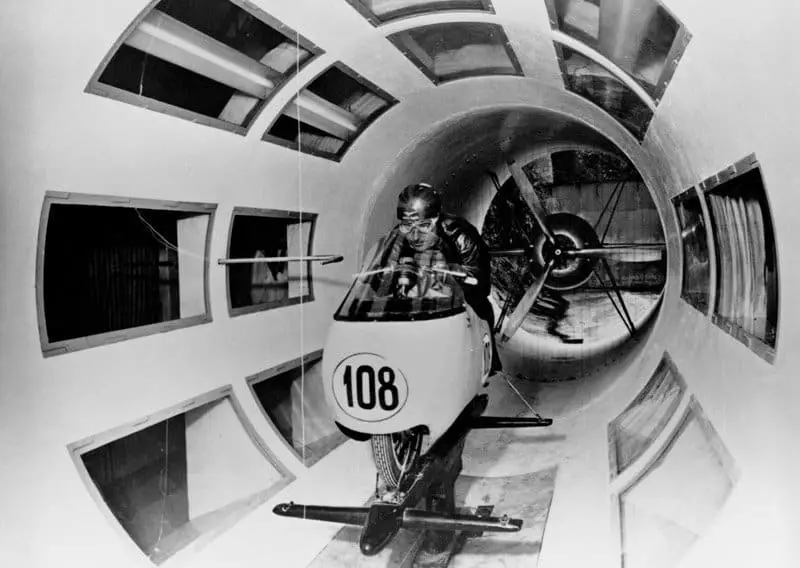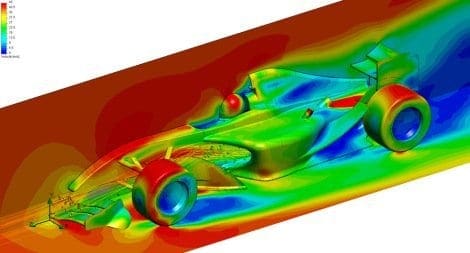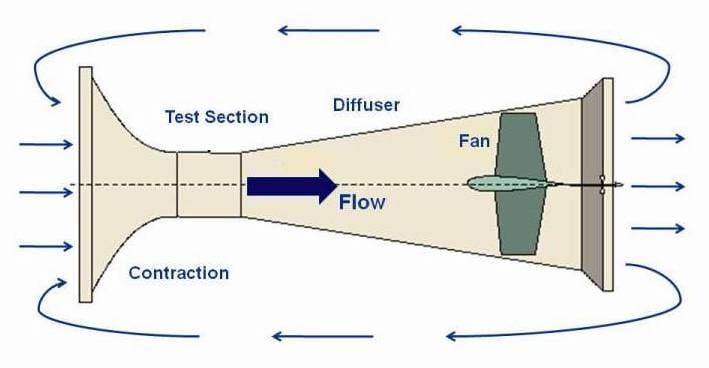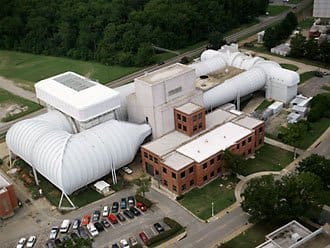How many wind tunnel types exist?
What is and which is the difference between wind tunnel types
What is a wind tunnel?
Wind tunnels are large tubes in which the air flows, simulating the actions of an object flying through the air or moving along the ground. We use wind tunnels to test scale models of aircraft, spacecraft, cars and motorbikes. Some wind tunnels are large enough to contain full-size versions of vehicles or just any part of it. In this article, we’ll treat the wind tunnel classification and their principal components.
Why are wind tunnels so important?
The possibility of carrying out tests in the wind tunnel is based on the so-called “reciprocity principle”, which states that from the point of view of the value of the physical quantities that are measured and the flow rate on the body, it is indifferent to move a body in a fluid stationary or move the fluid around a stationary body. So, instead of the air standing still and an object moving at speed through it, the same effect would be obtained if the object stood still and the air moved at speed past it. In that way a stationary observer could measure the aerodynamic forces being imposed on it.
The earliest wind tunnels were invented towards the end of the 19th century, in the early days of aeronautic research, when many attempted to develop successful supersonic aircraft and missiles.
Later, wind tunnel study came into its own: the effects of wind on man-made structures or objects needed to be studied when buildings became tall enough (like skyscrapers) to present large surfaces to the wind, and the resulting forces had to be resisted by the building’s internal structure. Determining such forces was required before building codes could specify the required strength of such buildings and such tests continue to be used for large or unusual buildings.
Which is the relation between wind tunnel tests and CFD (computational fluid dynamics)?
Still later, wind tunnel testing was applied to automobiles, not so much to determine aerodynamic forces per se but more to determine ways to reduce the power required to move the vehicle on roadways at a given speed. In these studies, the interaction between the road and the vehicle plays a significant role, and this interaction must be taken into consideration when interpreting the test results. In an actual situation the roadway is moving relative to the vehicle but the air is stationary relative to the roadway, but in the wind tunnel the air is moving relative to the roadway, while the roadway is stationary relative to the test vehicle. Some automotive-test wind tunnels have incorporated moving belts under the test vehicle in an effort to approximate the actual condition, and very similar devices are used in wind tunnel testing of aircraft take-off and landing configurations.
The advances in computational fluid dynamics (CFD) modelling on high-speed digital computers has reduced the demand for wind tunnel testing. However, CFD results are still not completely reliable and wind tunnels are used to verify CFD predictions.
Two main wind tunnel types: open and closed circuit.
Wind tunnels are divided into two main categories:
- open cycle tunnels (EIFFEL type tunnels)
- closed cycle tunnels (PRANDTL type tunnels)
Another classification of wind tunnels distinguishes the latter from the flow velocity in the test chamber:
- incompressible subsonic tunnels if the current Mach number is between 0 and about 0.3;
- compressible subsonic tunnels if the current Mach is between about 0.3 and about 0.8;
- transonic tunnels if the current Mach is between 0.8 and 1.2;
- supersonic tunnels if the current Mach is between 1.2 and 5;
- hypersonic tunnels if the current Mach is greater than 5.
As we are interested in motorsport area, we’ll discuss about Automotive Tunnels where the air speed is subsonic. These fall into two categories:
- External flow tunnels are used to study the external flow through the chassis.
- Climatic tunnels are used to evaluate the performance of door systems, braking systems, etc. under various climatic conditions.
For external flow tunnels various systems are used to compensate for the effect of the boundary layer on the road surface, including systems of moving belts under each wheel and the body of the car (5 or 7 belt systems) or one large belt under the entire car, or other methods of boundary layer control such as scoops or perforations to suck it away.
The measurements that are carried out are typically measurements of: global and local speeds, pressure, temperature and forces exerted by the fluid on the body. In the wind tunnel the so-called visualizations of the pressure, temperature and force fields that are established on the surface of the body or of the flow velocity field are also carried out. In the first case, the surface of the body is coated with particular substances sensitive to temperature, pressure or frictional forces.
In the second case, special tracers are used, such as coloring substances or fumes that allow you to view the flow pattern around the body. Another way to carry out the visualizations is to use woolen threads attached to the surface of the body or to supports which are then suitably moved to study particular areas of the field.
In water tunnels, inks or opaque substances such as milk are also used as tracers, which has the advantage of not being polluting and of costing little, as well as having a density very similar to that of water. In supersonic tunnels (but in general in all tunnels with compressible flow) the visualizations are made exploiting the phenomenon of the refraction of light that passes through two substances with different densities.
Wind tunnel types description: open vs closed type.
Open loop tunnels.
The open cycle tunnels in the front are generally composed of a mouth and a duct with a constant section (usually with a section or circular or rectangular) where some devices are placed to control the quality of the incoming flow. This conduit is followed by another (circular or rectangular section) of a converging type, which ends at the starting point of the test chamber. The test chamber has a constant section and it is where the model of the object of which you want to study is inserted. In the test chamber the speed reached by the fluid is the highest, and precisely must be at maximum the design speed. If you want to see a working example of open wind tunnel, see this video.
How does a open wind tunnel works?
The test chamber is followed by a diverging duct (generally with a circular section) which is called a divergent or diffuser. At a certain point of the divergent there is the motor, electric and enclosed, to which one or more fans are connected. The fans have the task of transferring the kinetic energy generated by the motor to the fluid, which is thus sucked into the test section. These components are followed by a further divergent conduit for the compression of the flow and finally the expulsion section for the discharge of the flow into the external environment.
It is important to take into account that the fans, which as mentioned above have the task of transferring the kinetic energy supplied by the motor to the fluid, are located downstream of the test chamber; This is because, in addition to providing the fluid with the necessary kinetic energy, they also generate a series of vortices and turbulence downstream, the presence of which in the test chamber, and therefore on the model, would completely alter the value of the measurements made.
The disadvantages of an open tunnel are the noise and the apparent loss of energy due to the discharge of the accelerated fluid into the atmosphere. In reality the latter disadvantage does not occur entirely. This is because if you join the exit of the flow from the gallery with the entrance and then create a closed gallery (as is described below) pressure drops (i.e. fluid energy losses due to friction) would occur. This explains why open-cycle wind tunnels still exist and are used for low speed tests.
A far more significant disadvantage than that just described is given by the fact that the test chamber is closed and the pressure inside it is lower than the external one (see Bernoulli’s theorem in this regard). Precisely because of this, the test chamber must be perfectly sealed to prevent infiltration of fluid from the outside which, being at higher pressure, would penetrate the chamber, significantly altering the flow pattern around the model and therefore the measurements made.
Closed loop wind tunnel.
Closed loop tunnels have the same main components as open loop tunnels. The only difference is that instead of being expelled outside the tunnel, the flow is recirculated inside. The advantages compared to the open solution are in the possibility of varying the characteristics of the fluid used (pressure, temperature, humidity, viscosity and so on) and of being able to use an open or semi-open test chamber, with considerable simplifications in terms of logistics in positioning the models to try. Closed-loop tunnels must be equipped with heat exchangers and radiators capable of cooling the fluid which gradually heats up as it flows, with the possibility of altering the measurements made.








